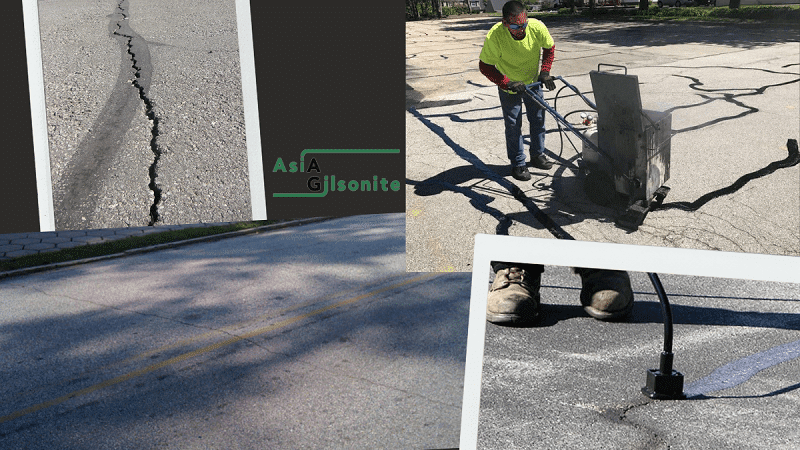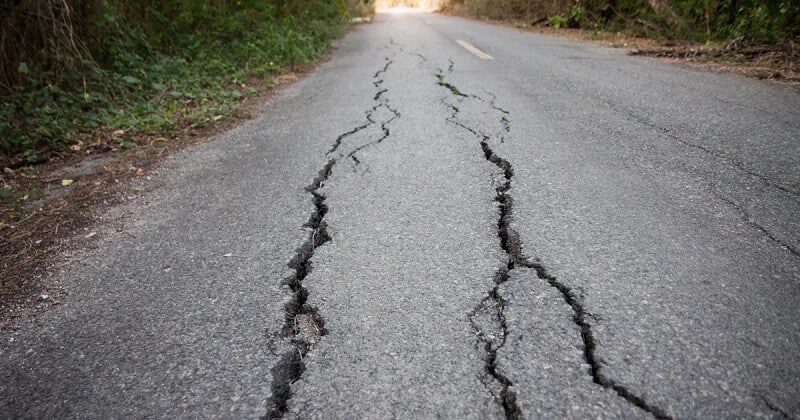Transverse cracking is caused by temperature changes and heavy traffic, while longitudinal cracking is a result of joint construction difficulties. This article examines the causes of transverse cracking in asphalt pavements and longitudinal cracking in asphalt pavements, which can greatly affect their durability and functionality. Timely repair and maintenance are essential to avoid additional damage and expensive repairs.
What Is Transverse Cracking?
Transverse asphalt cracking commonly occurs when the asphalt is exposed to cooler temperatures or experiences a decline in temperature before it has fully hardened. This phenomenon, also known as thermal cracking in asphalt pavement, is primarily observed when the hot asphalt mixture is still warm.
What Causes Transverse Cracking in Asphalt?
As the climate gets colder, the asphalt undergoes a process of contraction and shrinkage due to tightening. Consequently, it develops cracks that run perpendicular or transverse to the centerline of the pavement.
This type of cracking is particularly noticeable on concrete pavement that endures heavy daily traffic. While cool temperatures initiate thermal cracking in asphalt pavement, the continuous weight and pressure from excessive use and moving vehicles exacerbate the problem, and this is one of the causes of transverse cracks in asphalt pavement.
Initially, transverse asphalt cracking appears on the surface of the pavement. However, if these transverse cracks in asphalt pavements are not promptly repaired, they gradually deepen and extend beneath the surface. The damage is further compounded by changing weather patterns and climates.
Precipitation, such as heavy snow or rain, can accelerate the erosion of the cracks over time.
Transverse Cracks in Asphalt Pavement
When the frigid air mingles with the scorching asphalt mix that is still moist, a phenomenon known as thermal cracking can occur within the asphalt pavement. This occurrence, more than anything, poses an unwelcome inconvenience for owners of parking lots and driveways.
Alas, the repair of transverse cracks becomes an unavoidable necessity, for if neglected for too long, they can pave the way for further complications and potentially exorbitant repairs in the distant future.
The optimal course of action is to promptly mend these cracks upon their initial detection, thwarting their expansion into tertiary cracks. These secondary cracks can pave the way for additional weather-induced damages, such as erosion caused by water
How to Repair Transverse Cracking
To address the issue of transverse asphalt cracking, there are several approaches available, each tailored to the severity of the cracks. Here, we present a range of commonly employed methods:
Dynamic Sealing
A technique that involves the application of a heated rubberized asphalt compound to fill the cracks. This compound creates a flexible seal, effectively preventing water infiltration and further deterioration. Dynamic sealing is particularly effective for smaller cracks, significantly prolonging the lifespan of the pavement.
Crack Replenishment
Similar to dynamic sealing, crack replenishment entails filling the cracks with an appropriate material. However, this method is typically employed for wider cracks. Various substances, such as asphalt emulsion, asphalt cement, or specialized crack fillers, can be utilized to replenish the cracks.
Crack Revitalization
In cases of more extensive cracking, crack revitalization becomes necessary. This method involves the removal of the damaged section of asphalt, followed by the replacement with fresh asphalt. The affected area is meticulously cleaned, compacted, and then filled with hot mix asphalt to seamlessly blend with the surrounding pavement.
Milling and Rejuvenation
When transverse cracking is widespread and the pavement has significantly deteriorated, milling and rejuvenation may be the optimal solution. This process entails the use of milling machines to remove the top layer of the asphalt pavement, subsequently applying a new layer of asphalt to restore the surface to its former glory.
Comprehensive Restoration
Should the transverse cracks extend throughout the entire depth of the pavement, a comprehensive restoration technique known as full-depth patching is required. This method involves the removal of the damaged section down to the base or subbase, addressing any underlying issues, and then replacing it with new asphalt or concrete.
What Is Longitudinal Cracking
Longitudinal cracks emerge in alignment with the pavement’s central axis. Their origins can be attributed to various factors, such as an inadequately executed joint, contraction of the asphalt layer, the propagation of cracks from a lower stratum, or the separation of materials along the length due to suboptimal operation of the paver.
What Causes Longitudinal Cracking
Let’s discuss the causes of longitudinal cracks in asphalt pavement:
Challenges in joint construction or placement
The compaction of joints in pavements poses a significant challenge. It is difficult to position a roller in a way that fully compacts the joint without either partially resting its weight on the adjacent pavement, which creates a bridge over the newly paved longitudinal joint, or missing the newly compacted joint due to insufficient proximity to the edge. Ideally, longitudinal joints should be constructed outside of the wheel path to minimize frequent loading.
Cracks caused by underlying layer movement
When an underlying crack shifts slightly, it exerts stress on the layer above it. Over time, this stress can lead to the formation of a crack that aligns with the underlying crack.
Hot mix asphalt fatigue
The initial signs of fatigue cracking often manifest as longitudinal cracks near or within the wheel path. These cracks serve as a precursor to future alligator cracking.
Surface-initiated cracking
In pavements with considerable thickness relative to the applied load, cracks can originate at the surface. These cracks result from the tension induced by wheel loads, combined with the aging and increased brittleness of the asphalt surface layer.
How to Repair Longitudinal Cracking
The strategies employed for addressing cracking in pavement depend on the severity and extent of the issue:
For cracks of low severity, which are less than half an inch wide and occur infrequently, the recommended approach is to seal the cracks.
This prevents moisture from seeping into the subgrade through the cracks and also prevents the edges of the cracks from deteriorating further. By keeping these cracks sealed, the hot mix asphalt (HMA) can continue to provide satisfactory service for many years.
On the other hand, when dealing with high-severity cracks, which are wider than half an inch and occur in large numbers, a more extensive solution is required. In such cases, it is necessary to remove the cracked pavement layer and replace it with an overlay. This ensures the structural integrity of the pavement and helps to prevent further damage.
Conclusion
Transverse cracking in asphalt pavements and longitudinal cracking in asphalt pavements are common types of damage that can have a significant impact on their durability and functionality. Different methods, such as dynamic sealing, crack replenishment, crack revitalization, and more, can be used depending on the severity of the cracks. By effectively addressing these issues, the lifespan and performance of asphalt pavements can be greatly prolonged.






